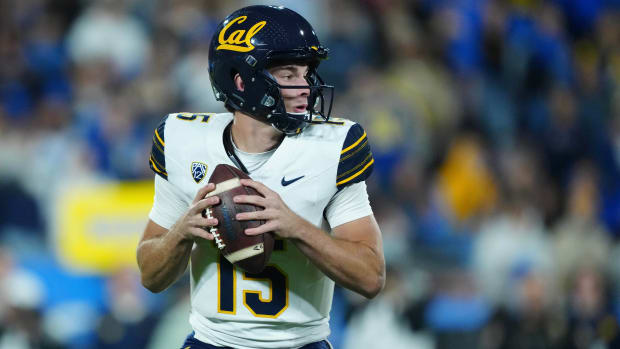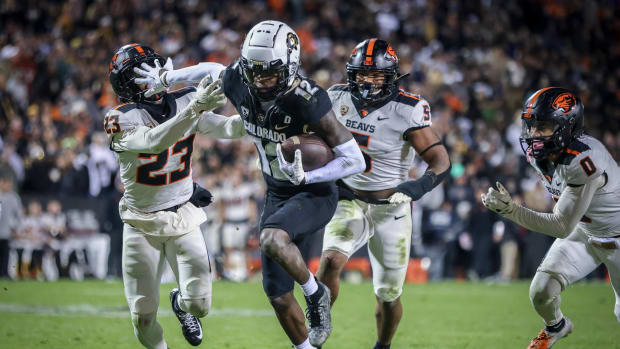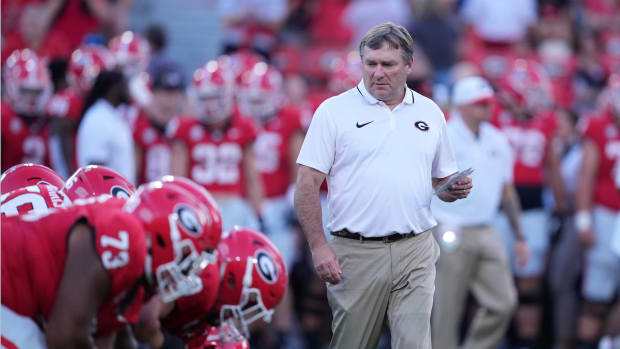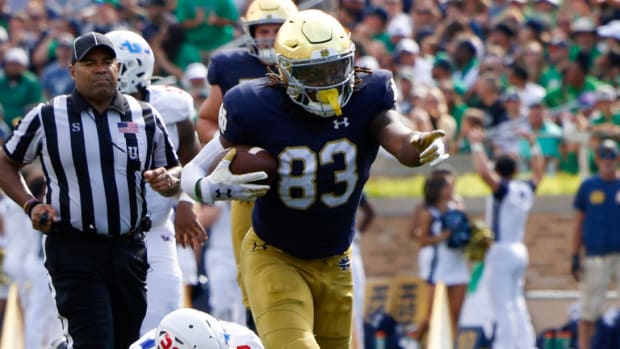The power of not punting: Why a college coach should adopt Kevin Kelley's unconventional philosophy
DALLAS — I thought Kevin Kelley would be more upset. He certainly seemed upset about 45 minutes earlier. At that moment, the coach who never punts had to break down and punt one time. But after dodging a water-bucket bath and celebrating a 40–13 victory last Friday that snapped the opponent’s 84-game home winning streak with his Pulaski Academy players, Kelley seemed quite Zen about doing the thing he has spent most of his coaching career trying to avoid. “I didn’t really hate it at all,” Kelley said afterward. “It is what it is if the situation dictates it’s something that we have to do. It’s all about winning. It’s never been about anything else.”
If you follow football trends, you’ve probably already done the math here. Kelley is that coach from Little Rock, Ark., who doesn’t punt, always attempts onside kicks and generally defies all of football’s conventional wisdom. He has been profiled everywhere, including twice on HBO’s Real Sports. He has a 138-24-1 record at Pulaski Academy with four state titles. Last Friday, Kelley brought his team to Highland Park (Texas) High to face the only team that beat the Bruins in 2014. The Scots hadn’t lost a home game since 1998. I wanted to see for myself why something that seems so insane in theory works so well in practice. After spending a game on the Pulaski Academy sideline, two things stood out.
• The Bruins don’t win because they don’t punt or because they attempt onside kicks every time or because their receivers routinely lateral on plays that aren’t the last one of the game. They win because of the attitude Kelley’s approach instills on Pulaski Academy’s sideline and the mindset it instills on the other sideline. The Bruins always play as if they’re down 10 with 90 seconds to go. Think about all the points you’ve seen scored in that type of situation. The offense plays as if it has nothing to lose. The defense tightens, playing to protect the lead rather than to advance the cause. That’s every minute of every Pulaski Academy game.
• Why hasn’t some college coach whose team is perpetually doomed by history and circumstances tried this? Instead of playing conventionally, losing and getting fired every three-to-five years, why wouldn’t David Beaty at Kansas or Darrell Hazell at Purdue try something dramatic in an attempt to close the talent gap between their teams and their opponents? Nearly every great football innovation has come out of an attempt to close a talent gap. Turning the psychological tables the way Pulaski has might be the next great innovation.
[video:http://bcove.me/acm5m4ug]
The crazy part about Kelley’s system is it isn’t crazy at all. It’s based entirely on math. Each yard line has an expected point value. Each down-and-distance has an expected rate of success. Punting average is easily calculated, as is punt return average. Years of football data have created these numbers, and while they differ between high school, college and the NFL, they do not differ as much as you might think. It’s fairly easy to use these numbers to create a do-I-go-for-it-on-fourth-down formula similar to the do-I-hit probability combinations in blackjack. Two years ago, Paul Dalen wrote an excellent piece at SB Nation’s Football Study Hall explaining the math behind Pulaski Academy’s madness. Here’s a snippet in which Dalen explains why a team should go for a particular fourth down from the 50-yard line.
In the example above, the fourth-down spot is the 50-yard line. The expected P(conv) is .50, the team’s average punt (chosen for example purposes) is 40 yards and the opponent’s average return is 10 yards. In this scenario, the expected point value of going for it is 0.0 points, and the expected opponent point value of punting is minus-1.8 points. Zero is more than minus-1.8, so going for it is justified.
For most of us, decades spent watching football played a certain way has taught us that the only prudent choice is to punt and play defense. But the math indicates that punting is actually the riskier choice.
So, why are college coaches—especially the ones whose teams are likely to lose most of their Power Five-versus-Power Five games anyway—so reluctant to try something the math suggests could work? Another byproduct of watching the Bruins play is that it becomes impossible to keep from yelling at the television when a team punts on fourth-and-two from its 45-yard line. For example, in Purdue’s 41–31 loss at Marshall on Sunday, the Boilermakers punted on fourth-and-five from the 50-yard line in the waning seconds of the first half. The Thundering Herd would have had precious little time to get in position for a field goal, but Purdue—which had just completed an 11-yard pass on third down—might have gained 15 or 20 yards and set up a field goal attempt of its own. The math favored the engineering school, but the Boilermakers punted anyway. After seeing Pulaski Academy play in person, I imagine this sort of thing will drive me crazy from this point forward.
Kelley also occasionally finds himself angry at the television, even though he has tried repeatedly to tell himself to stop watching like a math-obsessed coach. “I try to watch the game as a fan and not a coach, but even then it does drive me crazy,” Kelley says. “Especially when it’s a fourth-and-one or fourth-and-two, I know 100% of the time they ought to go for it. But who am I to question those guys? They have a plan, and they’re going to stick with it. I have a plan.”
The problem is, if coaches such as Hazell or Beaty stick to conventional football wisdom, the math says they’re likely to get fired. In February, Zach Barnett at FootballScoop.com put together a handy list of FBS head coaching tenures. The median length is that of Akron’s Terry Bowden, who was hired in 2011. So why, knowing that the odds are stacked against them from a talent standpoint, wouldn’t a few coaches try something drastic?
Some coaches have done just that, but that requires imagination on their part and faith on the part of the administration that hired them. Georgia Tech’s Paul Johnson is the only Power Five coach who runs the option as his base offense. Despite middling results before he got there and academic requirements that limit which recruits he can take, Johnson has won an ACC title. Last year his team went 11–3, won the ACC Coastal Division and pushed then unbeaten Florida State to the limit in the ACC championship game. The option takes away the need to recruit blue-chip quarterbacks, allowing Johnson to pull from the far deeper pool of athletic high school quarterbacks who would have otherwise been moved to tailback or safety in college. It also changes the math for offensive linemen. It’s tough to find ready-made 315-pounders. Alabama and Ohio State are going to get those guys. But the option puts a premium on speed and athleticism for linemen. There are far more lean(ish) 265-pound high school linemen who might grow into 300-pound monsters, and Johnson can recruit from that pool.
Even the most talent-heavy offense in college football is based on previously crazy ideas designed to close a talent gap. Ohio State trots out a bunch of former five-star recruits, but it runs plays based on single-wing concepts that were drawn up when Urban Meyer was trying to maximize the talent he inherited at Bowling Green in 2001. Those plays later allowed Utah to become the first BCS buster. At Ohio State, former offensive coordinator Tom Herman convinced Meyer to add another element once considered wacky—the no-huddle, hurry-up scheme pioneered, in different ways, by Rich Rodriguez and Hal Mumme—and the offense got even better.
This stuff can work, but someone has to be willing to try it. Kelley has seen the results time and time again. To him, his methods are no longer crazy. They’re normal. Yes, his team punted last Friday. It was up 10 in the third quarter, and Highland Park was storming back after falling behind 27–0 in the first half. The Bruins faced fourth-and-30 from their own 16. The math said to punt, so Kelley called for a punt. (In an angry huddle on the sideline, Kelley briefly explained the mechanics of punting as if he was introducing an Earth custom to an alien species.) Highland Park took over in Pulaski territory and immediately got sacked. Two incompletions later, the Scots faced fourth-and-20 from the Pulaski Academy 49. As expected, the Scots chose to punt. The snap flew over the punter’s head. The Bruins recovered on the Highland Park 13. They scored a touchdown on the next play, and the game was essentially over. The rugby lateral scheme Kelley’s team worked on all summer wouldn’t even be necessary. The Bruins would use only two plays from that package. It was as if the football gods were sending a message: Never, ever punt unless you absolutely have to.
Kelly gets attention for the onside kicks and the lack of punting, but every concept he embraces either puts pressure on the other team or minimizes risk for his team. Fellow coaches are aghast when he tells them that his team has no set distances on its out, stop and curl routes. “We don't run any five-yard stops or 10-yard outs or anything like that,” Kelley says. “Everything is push until the defender opens his hips. Then you break or stop or curl.” Other coaches ask: How can the quarterback and receiver develop timing if the quarterback doesn’t know when the receiver will break? They can’t, Kelley replies. But guess what the opponent can’t do? If the corner has turned his shoulders or flipped his hips, he can’t break on a poorly thrown out and turn it into a pick-six. Kelley has traded timing for the removal of risk from the game’s riskiest throws.
This reaction isn’t all that different from coaches who ask Baylor’s Art Briles why he lines up his receivers wider than the numbers. After all, because the wideouts are so close to the sidelines, they can’t run out routes. But Briles is happy to give up the out if it forces opposing defensive coordinators to choose whether to float a safety out further to help the cornerback (in which case the Bears will run the ball) or leave the corner on a very lonely island (in which case Baylor will throw to him).
A friend of Kelley’s who used to coach high school ball in Arkansas—and who had some ideas about offense that were once considered pretty bizarre—has told Kelley that football is football, and the concepts that work at the high school level can also work at the college level. That friend is Gus Malzahn, who has a national title as Auburn’s offensive coordinator and an SEC title as the Tigers’ head coach. So, why hasn’t some college team scooped up Kelley, or at least stolen all of his ideas? Unlike the systems that Malzahn and Briles brought from high school to college, Kelley’s bucks conventional wisdom so much that it seems too radical. “It all comes down to risk aversion,” Kelley says. “The coaches I’ve talked to, a lot of them will say, ‘We think you’re right. We think we should.’ But they’re afraid of the media or the fans or losing their jobs. I think that’s the bottom line.”
Eventually, some college coach will try a version of Kelley’s scheme. Maybe some college will hire Kelley. Or maybe some coach in Beaty or Hazell's situation will do the math and realize his job is only going to last for a few years if he doesn’t try something dramatic and change the probability. Going punt-free may not work. But playing conventionally probably won’t, either. Why not try?
“It may be something like the forward pass was way back when,” Kelley says. “At first, not a lot of people did it. Now it’s the dominant part of the game. I actually don’t want [my style to catch on], because now we have an advantage.”






